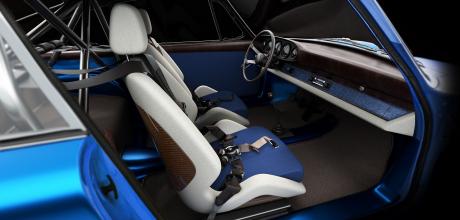CALLUM’s new recipe for a more sustainable automotive interior
According to a new study by design and engineering consultancy, CALLUM, coffee, eggs, walnuts, rice and lentils could be just as likely found in your future car’s interior as they would your shopping basket. The company’s designers and engineers went beyond materials already under consideration to identify fresh sustainable options its customers could benefit from through its new Sustainable Materials Study (SMS). Using a classic 911 restomod interior as the basis for the research, the team led by Charlotte Jones and Ian Callum identified coffee pulp, eggshells, red lentils, walnuts and rice as viable materials for a car interior in 2030.
With thousands of tonnes of food wasted every day in the UK alone, CALLUM consulted with green-tech company, Ottan, to determine the most appropriate materials capable of replacing plastics, yet still meeting the rigorous design, environmental and engineering requirements of a car. Solutions identified to meet typical temperature and wear specifications included eggshells mixed with resin to create a smooth, opaque material with either a glossy or matte surface. Application examples include the trim surround for the 911’s window switches. By adding walnut shells to the eggshells, the recycled content of Ottan’s material increases from 78% to 84%.
Out-of-date rice or lentils can be turned into a smooth translucent material, ideal for illuminated areas of the host vehicle, such as lamp covers or switchgear. As a flame-resistant alternative, coffee pulp could replace traditional plastics for glossy, decorative trim, including dashboard inserts. Keen to demonstrate sustainable materials can still offer vivid colours, CALLUM identified purple carrot pulp produces a mulberry-like hue for trim parts. Also, tree leaves can be recycled into a dark, smooth surface offering an alternative natural finish to wood veneer for centre consoles and dashboards.
NO TIME TO WASTE
With seats requiring a blend of wear resistance, comfort and colour fastness, CALLUM opted for pre-loved materials usually sent to landfill. “Around the world, we consume roughly sixtytwo million tonnes of textiles per year, and around eighty-seven percent of the total fibre input used for clothing is either landfilled or incinerated,” says Jones. “Forward-thinking companies, such as Planq, take jeans, then shred and press them with potato or corn starch to create a hard veneer which could be used for seat shells or dash centres. The SMS design study was created by our team to illustrate an alternative approach to automotive manufacturing, and that we can support car makers and suppliers by identifying alternatives many consumers are increasingly looking for.”
The seat centre facings in the CALLUM design study use Camira, a fabric made from marine plastic waste, whilst the bolster surfaces are covered in Féline, a soft material produced from PET bottles. Each offers no weight penalty, another factor considered for the 911 restomod upon which the study is based. For the carpet, Jones proposes Econyl, a material using nylon carpets or fishing nets to create a hard-wearing fabric. For more information about CALLUM and its recent projects, visit callumdesigns.com.


